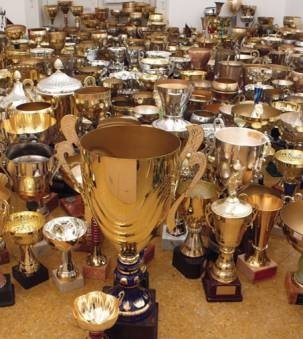Aleksandra Mir
dal 12/5/2009 al 25/7/2009
Segnalato da
12/5/2009
Aleksandra Mir
Schirn Kunsthalle, Frankfurt
Triumph. The exhibition collects together more than 2,500 trophies: sentimental objects representing the triumphs of others. Through this collection the artist looks at the history of the trophy and the ways we have of signifying victory -in sports and in the art world- as well as at the emotional moment of letting go, which every participant did in this project when they gave to Mir their souvenir of past grandeur.

Curated by Matthias Ulrich (Schirn)
Aleksandra Mir's new exhibition 'Triumph' for the Schirn Kunsthalle Frankfurt collects together more than 2,500 trophies: sentimental objects representing the triumphs of others. Through this collection the artist looks at the history of the trophy and the ways we have of signifying victory -in sports and in the art world- as well as at the emotional moment of letting go, which every participant did in this project when they gave to Mir their souvenir of past grandeur. The exhibition continues a programmatic focus at the Schirn Kunsthalle Frankfurt dedicated to solo exhibitions of current positions in contemporary art, for which 'Triumph' was specially developed.
The idea for 'Triumph' came to Mir while visiting a friend who had been a famous athlete in his youth. One room of his house, she says, served as a "shrine to his former glory"-full of certificates, plaques, photographs, newspaper clippings, and trophies. For Mir the room evoked beauty in all its facets: the vitality and power of a young body in motion, the echo of clapping hands, nostalgia and melancholy, the inevitability of being replaced by younger talent, and finally the premonition of death that would leave this archive behind. "I wanted," Mir says, "to capture all these emotions and generalize them as common features in society."
Mir advertised in her local Palermo newspaper Il Giornale di Sicilia, asking readers to send her their sports trophies. The inquiry met with great response. Within a few weeks, more than 2,500 trophies had been sent to the artist's studio in Palermo or picked up by her from donors. They show success in such sports as soccer, bowling, auto racing, or Latin American dancing, as well as in more idiosyncratic pastimes like the artful arrangement of a city's Christmas lights or the breeding of canaries. One man, who had been a soccer coach for thirty-five years, allowed Mir to empty his garage, giving her more than a hundred trophies that his teams had won. (His wife was of the opinion that a shrine in the bedroom sufficed.) Mir found most touching the man who, having decided to give up breeding canaries, released all his birds, and no longer felt a need to hold on to the material relics of his hobby. A former long-distance runner told the artist that his children were now his greatest achievement, and his former fame no longer interested him. In conversations with the trophy owners, it became clear that most of them had given their trophies to the artist as a way to shed the past that was associated with them-to empty full rooms, to free themselves of material burdens, or to get rid of old, stagnating ties. The psychological aspects of letting go particularly interest Aleksandra Mir, in addition to the seemingly limitless aesthetic diversity of the objects. "Generally speaking, it is the trophies' cheap fakeness that allows these people to banalize the once-prized objects-and to get rid of them sooner or later," she says.
Much like the world of sports, the art world has evolved into a very popular and yet competitive field. Awards such as the Turner Prize, the Preis der Nationalgalerie für junge Kunst, and more than fifty biennials worldwide are the expression of a staged competition. "It doesn't take much to see the analogy between sports and art on the level of their respective social orchestrations," Mir observes. "Artists are as much driven by their internal demons as by power relations with their colleagues of the past and present. The biennial is modeled on the Olympic games-the awards speak for themselves."
ALEKSANDRA MIR (b 1967) is a Swedish-American Citizen, born in Poland, raised in Sweden, educated in NYC and currently living in Palermo, Sicily. Aleksandra studied Media, Communications, Fine Art and Cultural Anthropology and her art merges all these disciplines. She has been involved with over 150 international exhibitions and public commissions since 1996 including the Biennale of Sydney, the Whitney Biennial, Palais de Tokyo in Paris, the Institute of Contemporary Arts in London and the Solomon R. Guggenheim Museum in New York. In 2006 she presented her first museum solo show at the Kunsthaus Zürich. Her technically and logistically elaborate project Plane Landing, which consists of a life-sized inflatable passenger jet which last year was staged at the Zürich airport and various landmark sites in central Paris brought Mir a great deal of international attention. Aleksandra Mir will participate in the 53th Venice Biennale in June 2009.
Catalog: Aleksandra Mir: Triumph. Edited by Matthias Ulrich and Max Hollein. With a foreword by Max Hollein, a text by Gabi Langen, and an interview by Matthias Ulrich with Aleksandra Mir. German-English edition, 64 pages, 210 illustrations. Cologne: Verlag der Buchhandlung Walther König, 2009. ISBN 978-3-86560-576-4.
Image: Photograph in the artist's studio © and photo: Aleksandra Mir
Press contact: Dorothea Apovnik, phone: (+49-69) 299882-118, fax: (+49-69) 299882-240, e-mail: dorothea.apovnik@schirn.de
Opening may 13rd
Schirn Kunsthalle Frankfurt
Römerberg 60311 Frankfurt, Germany
Hours: Tues., Fri.–Sun. 10 AM–7 PM, Wed. and Thu. 10 AM–10 PM.



